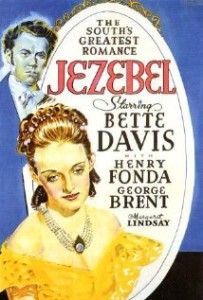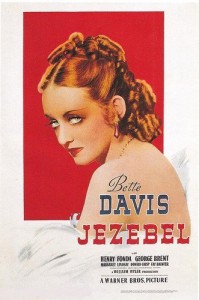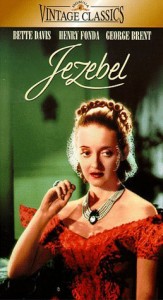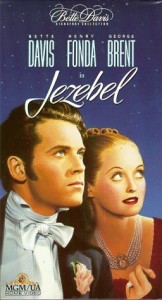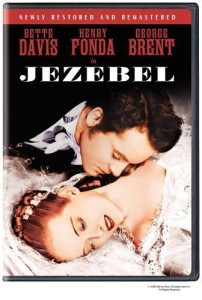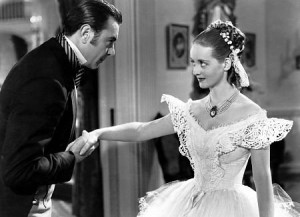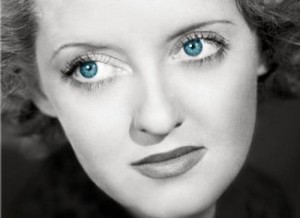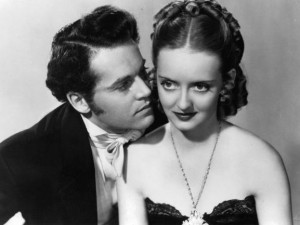Jezebel ***** (1938, Bette Davis, Henry Fonda, Margaret Lindsay, Fay Bainter, George Brent, Richard Cromwell, Donald Crisp) – Classic Movie Review 2698
Director William Wyler’s double Oscar-winning 1938 romantic drama Jezebel stars Bette Davis, who grabs one of the best chances of her glorious career by the scruff of its neck and triumphs. In many ways this is Davis at the height of her career and the movie is a quintessential example of the Hollywood golden era women’s film.
It won two Oscars – Best Actress in a Leading Role (Bette Davis) and Best Actress in a Supporting Role (Fay Bainter), with three other nominations – for Best Picture, Best Cinematography (Ernest Haller) and Best Music, Scoring (Max Steiner).
Costumed in Orry-Kelly’s brilliant gowns, Davis won the Best Actress Oscar as Julie Marsden, a young woman gifted with a dangerous power over men. Julie is a headstrong Southern Belle who flaunts her sexuality with a wilfulness that causes shock waves through 1850s New Orleans society.
In a mainly decorative role where he looks at his most handsome, Henry Fonda provides loyal support as her glum fiancé Preston Dillard, a successful young banker. He loves her but can’t cope with her controlling personality and sexual and emotional heat. So instead decides to run off with and marry a more sedate Northern girl, Amy (Margaret Lindsay).
So Julie finds she loses her fiancé because of her stubborn vanity and pride but, impelled by the same desperately flawed and insecure character traits, vows to win him back. And Preston, desperately flawed by his weakness, finds her magnetic attractions drawing him back to Louisiana. Julie plays North against South amid a deadly epidemic of yellow fever.
Oscar-winner Davis is on top form, backed up by a strong vintage cast of star supporting players, including George Brent as Buck Cantrell, Donald Crisp as Dr Livingstone and especially Fay Bainter, who deservedly picked up a Best Supporting Actress award as Aunt Belle Massey. Bainter was the first player to receive nominations in the lead and supporting acting categories, being nominated for Best Actress for White Banners (1938).
Jezebel is securely based on a sharp and incisive screenplay Clements Ripley, Abem Finkel and John Huston (based on a play by Owen Davis Sr). Director Wyler milks the tensions to the limit, with the help of Ernest Haller’s excellent black and white cinematography, Max Steiner’s shimmering score and the plush Warner Bros production. It is a slight shame that it is not in the Technicolor it seems to cry out for, but mostly the movie is a perfect showcase for Davis.
Also in the cast are Richard Cromwell, Henry O’Neill, John Litel, Spring Byington, Eddie Anderson, Gordon Olive, Janet Shaw, Georgia Caine, Irving Pichel, George Renavent, Fred Lawrence, Ann Codee and Lee Payton.
Davis’s Oscar statuette was sold at auction on July 19 2001 at Christie’s for $57,800 to Steven Spielberg, who donated it back to the Academy of Motion Picture Arts and Sciences. He also did this in 2002 with her Oscar statuette for Dangerous (1935).
Some scenes were filmed around Fonda, to allow him to be with his wife in New York as she gave birth to their daughter Jane.
Owen Davis Sr’s stage play opened on Broadway on 19 December 1933 and closed in January 1934 after only 32 performances. As the play with Miriam Hopkins and Joseph Cotten was a flop, Warner Bros could buy the film rights at a low price. Davis starred with Hopkins in The Old Maid and Old Acquaintance.
© Derek Winnert 2015 Classic Movie Review 2698
Check out more reviews on http://derekwinnert.com

